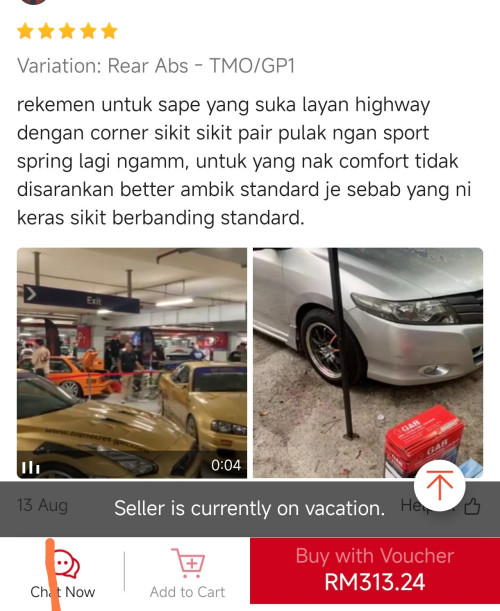QUOTE(Zhik @ Nov 27 2025, 07:24 PM)
Thanks for the sharing dude.
I wonder if u can help me with this.
My car ride is much better now after aligment and balacing. The steering felt bumpy when i drive at above 100km/h. I read that it is the road force factors.
How shall i tell the mechanic? How much does it cost? Where can i find that?
If will they check the tires and rim as well?
this problem from rim/tires can be fixed?
I can't not help you. Suspension is more like art than science.
What one complains can be desirable effect for another person.
Anyway some 2 cents here.
You mentioned you change mounting and bushing. If your mechanic tightening everything when car is in the air, then you need to find a different mechanic.
Find a reputable mechanic that can perform proper bushing preload release. Get the mechanic to ride with you together.
The shop should be 2 types of lift = Lift from the car body, lift from the wheel (or "longkang" at alignment shop also works).
Bushing preload release is most important step during installation (anything involved unscrew the suspension control arms)
1) Before dismantle, measure car height at all 4 corners when car is on the ground, write them down (from center of the wheel hub to the fender).
2) Lift the the car and remove the parts to be replace.
3) During installation, use a jack to life the lower control arm such that the wheel hub is at same distance from fender using measurement from step 1 (+/- 10mm, don't have to super precise, step 7 will take care of the precision).
4) Screw the parts, but do not fully tighten.
5) Drop the car to ground, drive forward and backward so that the car return to natural resting height.
6) Lift the car with lift that support the wheel, not the car body. Or drive to car alignment machine with "longkang".
7) Loosen all the control arm bushing, and tighten them to the factory OEM torque spec.
Additional not applicable to you.
8) If change sport spring, coilover that significantly lower the car 20-30mm+, need to loosen all the control arm and retighten when car wheel support the car weight. Many of them are difficult to access, so need a mechanical plate to install on the wheel hub instead of actual wheel for this exercise. 99% of mechanic don't have this, need to find tuning shop.
9) For commercial truck, if majority of time is fully loaded, we can also perform the bushing preload (purposely load, instead of release), when the truck if fully loaded. So that when truck is empty, the bushings are twisted, but closest to natural load free position when the truck is loaded. This prolong the bushing service life.
If didn't perform the steps above, the bushing are already twisting when car is resting on the ground. Not uncommon for the twisted bushing to add 10mm+ to car ride height.
The twisted bushings are adding stiffness on top of the car spring. Some more unevenly, adding to random harshness, bumpiness.Also the new bushings life will be significantly reduced. Image resting already twisted, during bump or ferry people, the bushing are twisted even more than designed if installed properly.
New bushing, new shocks take few days to break-in.
Mounting and bushing should not affect steering, not sure what you mean steering bumpy.
If the car is lowered, it automatically add additional camber for most road car, that will cause steering to weight heavier.
Higher castor angle also can add weight to steering, and cause steering self return to center faster.
Both camber and castor are non adjustable during alignment for a normal road car without modification.
This post has been edited by constant_weight: Yesterday, 11:51 PM 

 Nov 21 2025, 05:19 PM, updated 11h ago
Nov 21 2025, 05:19 PM, updated 11h ago
 Quote
Quote

 0.0141sec
0.0141sec
 0.46
0.46
 5 queries
5 queries
 GZIP Disabled
GZIP Disabled